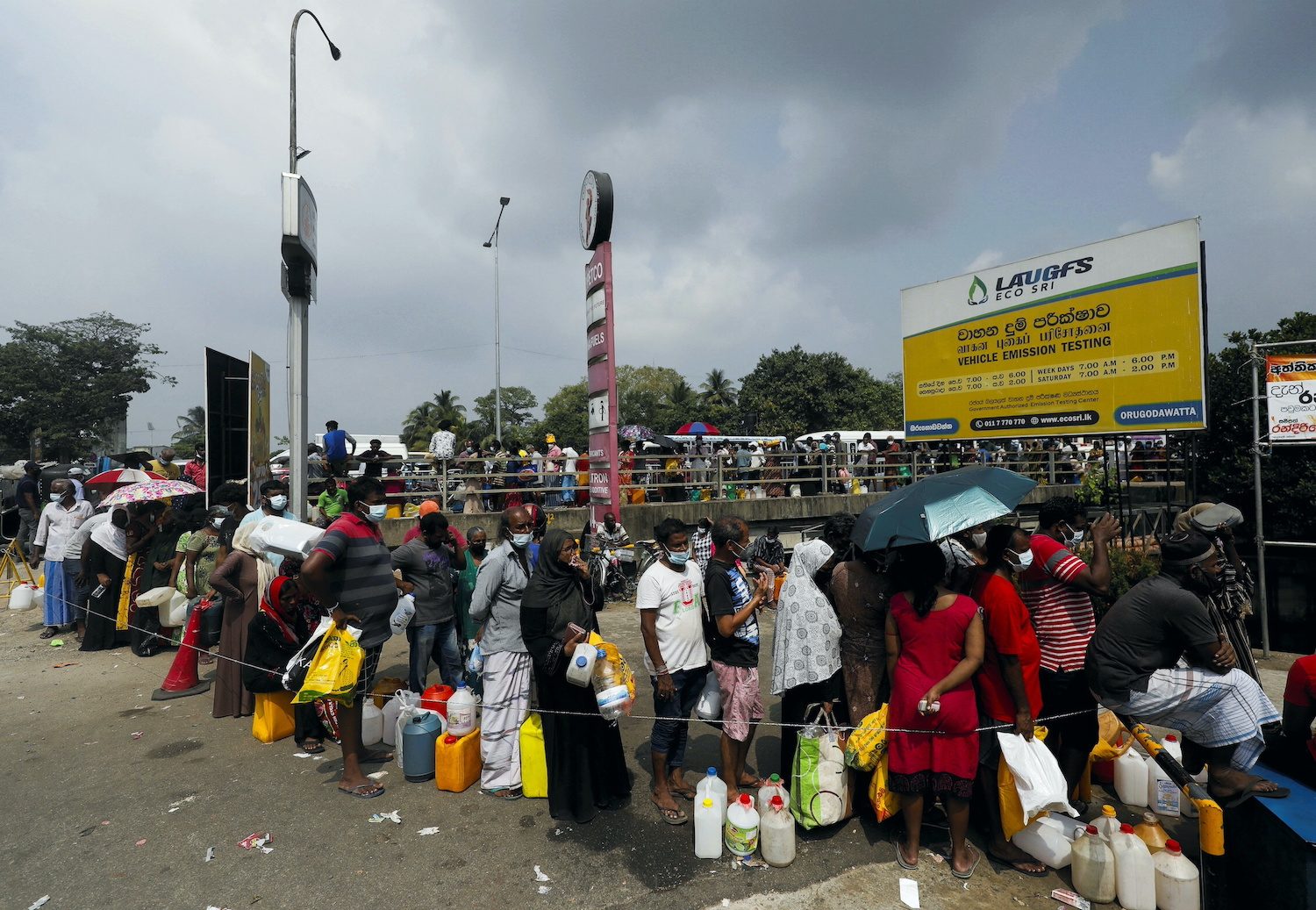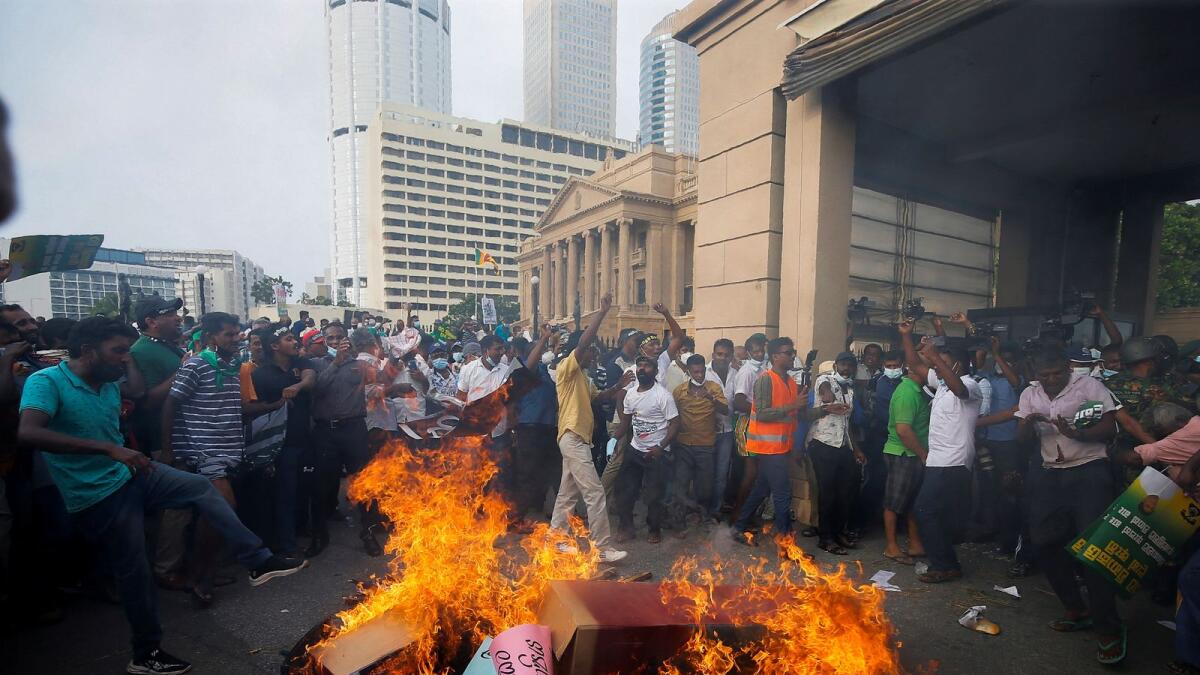How Sri Lanka’s Crisis Arose And Why Protesters Wreaked Havoc On Saturday

How Sri Lanka’s Crisis Arose And Why Protesters Wreaked Havoc On Saturday
Protesters in Sri Lanka had been demonstrating outside the president’s office for several months and invaded the building. It was said that they were spotted diving into the pool, going into the kitchen to grab any food they could find, and watching the news on television.
In the largest protest to date, thousands of Sri Lankans went to the streets on Saturday as the country’s economic situation worsened. Protesters attacked President Gotabaya Rajapaksa’s home. Demonstrators, who have been demonstrating in front of the president’s office for the last few months, invaded the building. It was said that they were spotted diving into the pool, going into the kitchen to grab any food they could find, and watching the news on television.
Although Sri Lanka’s economy is in a state of collapse and neighbouring countries and the International Monetary Fund (IMF) have given aid, political upheaval has further lowered the country’s economic recovery. Due to fast inflation and severe shortages of necessities, people today struggle to purchase food, gasoline, and other essentials. The public has harshly criticized the Rajapaksa family, blaming them for the current state of disarray in Sri Lanka owing to their alleged corruption and inexperienced leadership.
Let’s investigate the specifics of what went wrong for the island nation:
How did the protest begin?
Sri Lanka declared in April that it would put off repaying its international debt because of a lack of foreign cash. $51 billion is the total amount of its foreign debt, of which $28 billion must be repaid by the end of 2027. In the same month, President Rajapaksa issued an emergency proclamation. In less than a week, he withdrew it in response to massive protests by people who were upset with how the government handled the issue.
In April of this year, Sri Lanka made its first default on its foreign loans since gaining independence. The unrest sparked months of protests that toppled the political dynasty of the Rajapaksas. After violent demonstrations, the president’s older brother resigned as prime minister; three other Rajapaksa relatives had already left their Cabinet positions.
While Rajapaksa continued to enjoy the power despite mounting calls for him to step down, a new prime minister, Ranil Wickremesinghe, came into office in May to assist in leading the nation out of the crisis. On Saturday, hundreds of demonstrators seized the president’s beachfront office in a different neighbouring building while crowds of people smashed through barriers to occupy the president’s home. Some of the protestors were holding national flags.
What do demonstrators want?

The nation’s citizens are yelling, “Gota! Go Home,” calling for President Rajapaksa to step down. After protesters broke into his Colombo home on Saturday, the demonstrations grew more violent. The 22 million-person island country has been seeing protests for months and is currently suffering through its most significant economic crisis since 1948.
Both the president and the prime minister are being called to step down by the demonstrators. Protesters accuse the government of mismanaging the economy, which has driven up the cost of commodities. The unstable president is currently under army protection at military headquarters. Despite the ongoing protests, the prime minister, Ranil Wickremesinghe, notified political figures that he was willing to leave office in favour of a new government.
What level of crisis is there?
The 22 million citizens of the nation are subjected to debilitating 12-hour power outages and a severe lack of food, gasoline, and other necessities like medications. Sri Lanka relies on imports for necessities, including gasoline, food, and medication. Due to a lack of foreign currency in Sri Lanka, the cost of several commodities has increased.
A kilogram of rice that would normally cost about 80 Sri Lankan rupees has increased in price by 175%, to 500. According to sources, due to shortages, a 400g container of milk powder currently costs more than 250 rupees while it typically costs about 60 rupees.
The background to the crisis?

The foreign exchange gained through exports accounted for a sizable portion of its gross domestic product. The nation’s foreign exchange reserves have been put under pressure as exports have decreased over the years. Sri Lanka regularly had a balance of payments issues as a result. The nation has borrowed money from the IMF multiple times to get through tough times. However, the loans frequently include stringent requirements, such as lowering the budget deficit, upholding a strict monetary policy, limiting government subsidies for Sri Lankans’ access to food, and devaluing the currency.
These circumstances have increased the nation’s debt. Sri Lanka received its most recent IMF loan in 2016. From 2016 to 2019, the nation got $1.5 billion over three years. The circumstances were the same as always, and at this time, the economy’s health took a severe hit. While the debt load increased, growth, investments, savings, and income declined.
The economy was already suffering from a downturn in tourism, and the Covid-19 outbreak worsened matters. Additionally, the new administration of President Gotabaya Rajapaksa unreasonably lowered taxes, which resulted in a loss of income.
The Rajapaksa administration prohibited all fertilizer imports in April 2021, and the nation was proclaimed to only support organic farming. Although the program was abandoned later in the year, it caused a sharp decline in agricultural output and increased the need for imports. Food shortages developed due to decreased food import funding caused by decreasing export earnings.
Sri Lanka resembles the form of a teardrop that is dropping from Southern India. The portrayal belies the optimistic inhabitants of the island country. On Sri Lankan cricket fields, where their prepared bands play music throughout the play with drums, trumpets, and cymbals, you may hear hints of it. Even the ICC acknowledged that music played a role in Sri Lankan cricket. Did you get it? Happy country and everything.
It is, therefore, distressing to watch it plagued by economic problems that characterize a failing state after decades of rebellion that it suppressed (although in the most brutal way conceivable). As I watched rioters take over the presidential palace, one of the saddest things I heard from a commentator was that the nation didn’t even have the money to hold an election to choose its destiny. Worse, he said that worse is still to come.
Despite all of this, I notice that the Australian cricket team is still playing a Test series with a match still going on in Galle. It is bold and kind of Australia to stay in a country with no gasoline, and the lights are going out; I believe most other teams would have left. I have no clue how they will recover from it.
Their analysts claim that both China and India are assisting, but the decline does appear to have stopped as a result. An SOS for gasoline has been addressed to Russia. There have been no comments from the US, which seems to have avoided the situation after becoming drawn into Ukraine, where it is pouring billions of dollars in.
In South Asia, there are additional contenders for a failed state. Sri Lanka was never expected to be the one. Even in its most challenging moments, you didn’t hear that landlocked Afghanistan ran out of fuel. The events in Sri Lanka are mind-boggling.
A failed state exhibits the following traits:
- Loss of control over its territory or of the exclusive right to employ physical force
- Erosion of the rightful capacity for collective decision-making -Inability to deliver public services
- Impairment from engaging in full-fledged foreign relations with other states
- Sri Lanka satisfies the second and third requirements, and maybe even the first, given how easily rioters took over the parliament and the presidential residence.
To stop a total collapse, the entire globe must act. After visiting Sri Lanka in 2017, my family and I have nothing but beautiful memories and eternal love for this country. Since I was last there during the Civil War, reporting on both the IPKF’s unfortunate admission in 1987 and its regrettable withdrawal when VP Singh expelled them in 1990, I found the visit to be personally uplifting.
The highlight of the kids’ holiday, which they thoroughly enjoyed, was a trip to a turtle sanctuary in Bentota, where they interacted and played with newborn turtles raised in sizable ponds. Injured turtles were also cared for at the farm; one of them developed a particular affinity for my wife, who returned the favour. Sri Lanka will always be associated with kindness and love. How tragic that the nation, long wounded by insurgency, is now being destroyed by economic problems. All of my buddies in Sri Lanka and others who served there come to mind.
In the largest protest to date, thousands of Sri Lankans went to the streets on Saturday as the country’s economic situation worsened. Protesters attacked President Gotabaya Rajapaksa’s home. Demonstrators, who have been demonstrating in front of the president’s office for the last few months, invaded the building. It was said that they were spotted diving into the pool, going into the kitchen to grab any food they could find, and watching the news on television.
edited and proofread by NIKITA Sharma





